These days, web writing is a thriving industry because we depend on the internet for everything. Somebody has to write all those web pages, all of that content, and the billions and billions of words that make up the information highway.
That said, what sets your words apart from the rest? Why should people bother to read your online writing when they literally have millions of other options at their fingertips?
The answer lies in the fundamentals of online writing. When you have these keys down, you will be able to create online content that stands out, gets noticed, and impacts your readers positively.
It matters because online writing is a different beast from every other type of writing. You may borrow some techniques from other areas, like the fundamentals of creative writing, but, ultimately, this medium needs to speak to not just any type of consumer, but the online one.
[bctt tweet=”Create online content that stands out, gets noticed, and impacts your readers positively. Learn the fundamentals of #onlinewriting” username=”ExpWriters”]
Why the Online Reader Needs Tailored Writing
Here’s what we know about the online reader:
- They’re bouncing around from webpage to webpage. According to data from Chartbeat, 55% of people spend 15 seconds or less reading a webpage. If your writing doesn’t intrigue your audience from the first few sentences, they won’t stay to read more.
- More often than not, they don’t read web writing closely. Research from Dejan Marketing found that only 1 in 5 people will read your content word-for-word. The rest skim and scan pages, looking for the major points. They do this for various reasons, but the top two include impatience to find the answers they need, and avoidance of text that looks too long.
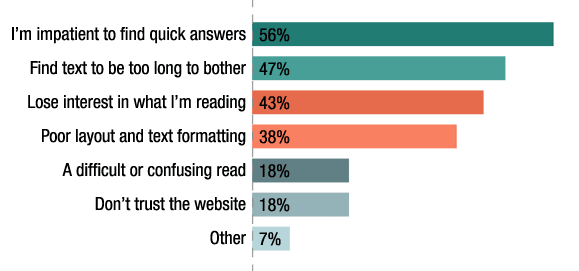
- Online readers are often searching for answers to their questions and solutions to their problems. The research above proves this is true: 55% said the main reason they don’t read full content is they’re looking for quick answers, not a long read.
These types of reading behaviors are fundamentally different from the habits of people who read physical books, for example. If your nose is in-between book pages, you don’t mind blocks of text, and you probably read every single word in front of you. Meanwhile, online readers take in content and information in a different way, so we have to tailor our online writing to make it as easy as possible for them to digest.
[bctt tweet=”Online readers take in content and information in a different way. Here are the reasons why they need tailored #onlinewriting” username=”ExpWriters”]
As long as you have the fundamentals down, it’s not hard to fit your words to the web. For writing in general, think of it as another tool in your toolbox – a way to grow your skillset and flex your writing muscles.
Ready to learn the 5 fundamentals of online writing? Let’s go.

The 5 Fundamentals of Writing Online
- Get to the Point (Use the Inverted Pyramid Style)
- A.A.F. – Always Avoid Fluff
- (Spell) Check Yourself
- Format for Scanners, Write for Readers
- Create Content That Matters (Map to Stages of Buyer Awareness)
The Fundamentals of Writing Online: 5 Keys to Engage and Impact Online Readers
1. Get to the Point (Use the Inverted Pyramid Style)
If we’ve learned anything thus far, it’s that most online readers want answers now. They want the cliff notes so they can skim or speed-read straight to the information that concerns them most.
While some people DO still read content in full, they aren’t the majority. That said, we don’t want to alienate anyone from reading our online content.
To appeal to the impatient skimmers, the in-depth readers, and everyone in-between, we can rely on the inverted pyramid style of writing. Amy Schade for the Nielsen Norman Group has another name for this technique: writing for comprehension.
This means you begin your blog or article with the most important information right off the bat. There is no teasing, no dangling the carrot, and certainly no beating around the bush. This is a KEY fundamental of online writing.
As your article continues, you order your points from “need to know” to “nice to know”. The least important information wraps up the end of the piece.

Look at this example of a blog from the Nielsen Norman Group. It begins with the main points and tells you exactly what you’re in for with a mini summary. The points that immediately follow tell you important details (what a customer journey map is and why you might need one):
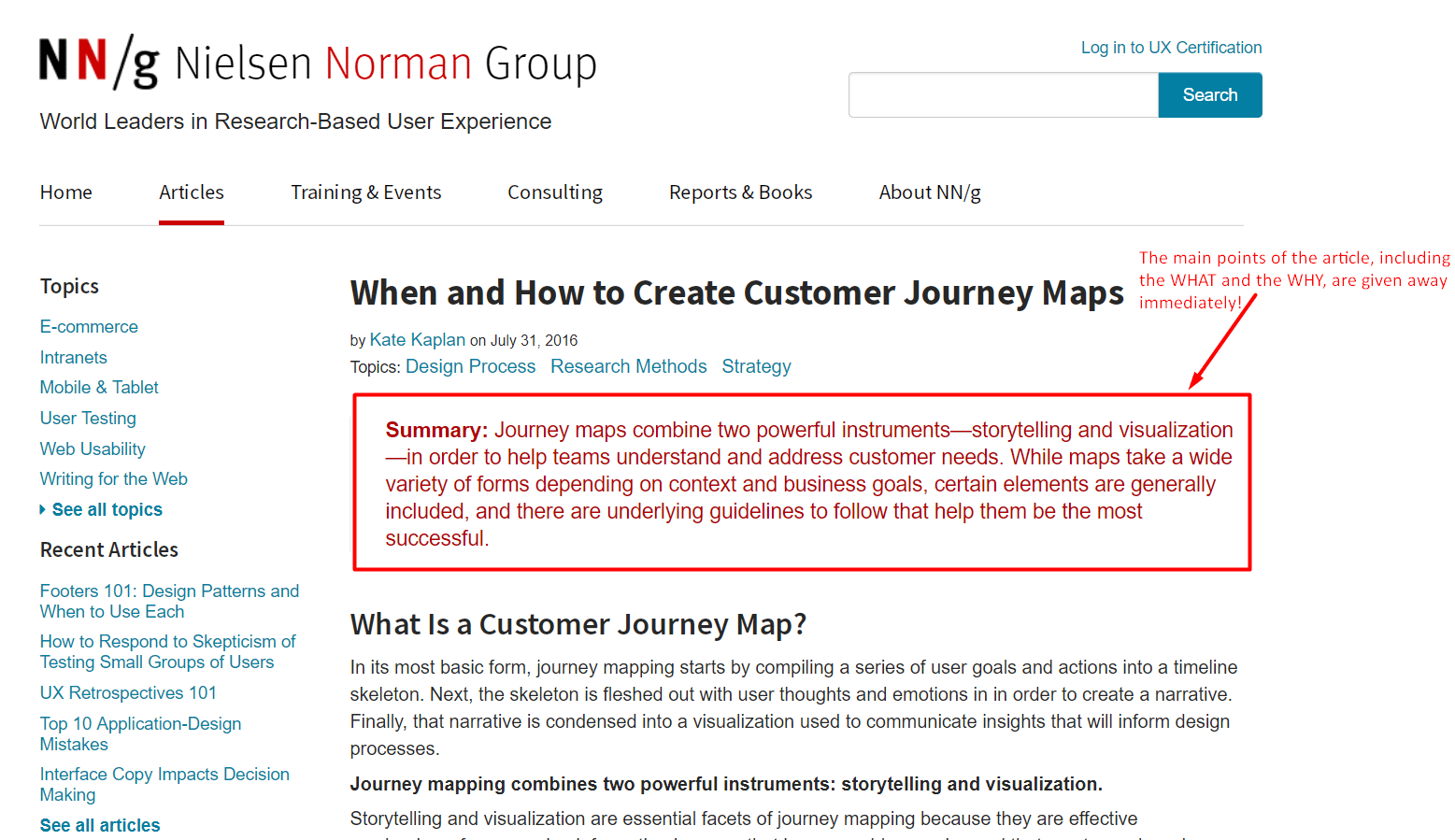
The final points go into further detail – it’s stuff you don’t NEED to know to understand journey maps, but is NICE to know if you want more information.
This writing technique originated with early journalists. The idea was to give readers the most important details of a story, first, so they could understand the main point without having to read further (unless they wanted more details). If your main point was unclear in your piece, this was called “burying the lede” – a major no-no.
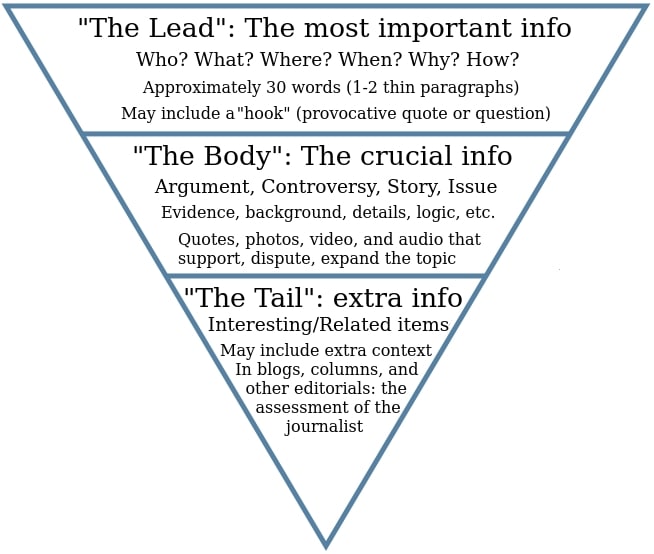
However, giving away the most important information at the beginning doesn’t mean you’re scot-free to do whatever you want after that. The rest of your blog or article should still contain good supporting information.
That leads us to our next point.
2. A.A.F. – Always Avoid Fluff
Using the inverted pyramid style of writing does NOT mean you front-load your blog or article with all the juicy bits, then slack off for the rest of the piece with filler.
That’s why the second fundamental of online writing is A.A.F. (Always Avoid Fluff).
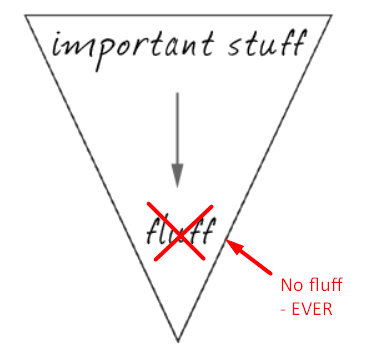
What is fluff/filler? In writing, this is the use of repetitive wording, unnecessary details, meaningless phrases, or other diversions from the main topic that serve only to pad your word count.
Here are a few examples of filler phrases in action:
Concerning the matter of the test, she passed with flying colors.
At this point in time, that’s not an option.
Sally doesn’t want to study because of the fact that she has a headache.
These phrases don’t add any information to their sentences – you can remove them completely without losing meaning:
She passed the test with flying colors.
That’s not an option.
Sally doesn’t want to study because she has a headache.
Another version of fluff is restating points you have already made by changing up the wording.
Example:
She passed the test with flying colors. She didn’t even have to try to pass the test.
Both of these sentences get across the exact same information. The second sentence uses repetitive wording to restate what we’ve already revealed (we get it, she passed the test). The second sentence is total fluff.
As you can see, fluff weighs down your writing. It makes it slow, boring, and redundant. Online readers have no patience for this kind of crap!
[bctt tweet=”Always remember: A.A.F. — Always Avoid Fluff. Read more about why and how to get rid of fluff, plus the other fundamentals of #onlinewriting” username=”ExpWriters”]
Hot tip: If you fear you’re unintentionally stuffing your sentences and paragraphs full of fluff, use an editing tool that can help weed it out. (Hemingway Editor is particularly good at this!) To learn what words are common fluff targets, check out this infographic and get familiar with fluffy words and phrases you can cut from your writing without losing meaning or impact.
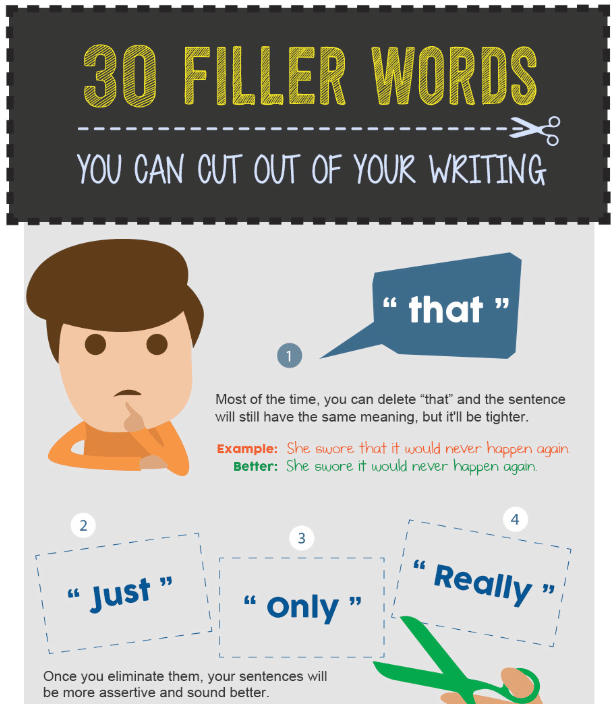
3. (Spell) Check Yourself
Any good online writer worth their salt should have an arsenal of editing tools at their disposal. Often, a round or two of edits is all it takes to transform sub-par writing into a zinger of a piece.
For web writing, in particular, editing is a crucial step you must not skip. The editing phase helps you accomplish major writing goals:
- Trimming fluff and filler!
- Correcting grammar and spelling mistakes so your writing is as clear as possible.
- Optimizing your formatting and the structure of your piece.
- Making sure your most important points are at the top.
- Fact-checking and reviewing sources for accuracy and authority.
As you can tell, you’ll need more than a simple spell-checker to accomplish these (though it doesn’t hurt to start there). In fact, it’s a good idea to rely on more than one editor, including:
- Your own eyes, preferably after you’ve stepped away from the piece for awhile
- Automated grammar checkers (think plug-ins for your word processor/WordPress – tools like Grammarly or ProWritingAid)
- A human editor (other than you)
Editing is not only a key fundamental for online writing; it’s also essential for ANY kind of writing, period.
[bctt tweet=”Editing is not only a key fundamental for #onlinewriting; it’s also essential for ANY kind of writing, period.” username=”ExpWriters”]
4. Format for Scanners, Write for Readers
Another major online writing fundamental to nail is formatting. Without the right formatting, your blog, article, or webpage will be hard to read and, perhaps more importantly, hard to scan. Online readers WILL bail on a piece with poor formatting, even if it’s written well.
When you format, think of ways you can break up the text and add meaning to your paragraphs. I’m talking about headers, lists, and bullet-points.
Headers, in particular, help outline the text and provide clues about the information inside it.
For example, maybe I want to know how to read my dog’s body language so I can understand her better. More specifically, I want to know what it means when she wags just the tip of her tail. I find an article that looks promising. I skim the headings to locate the information I need:
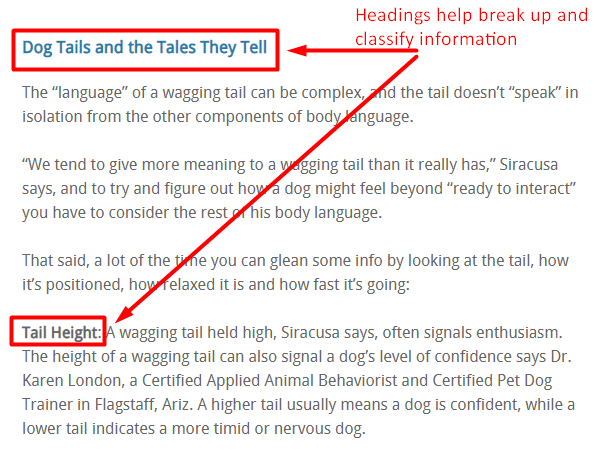
In this way, headings are ultra-useful for those online readers who skim and scan. Without the headings, it’s much harder to understand what information an article or web page contains at a glance. A few more tips:
- Include headers where they make sense, and use them to “outline” your writing. Do the same with bullet points and numbered lists.
- Don’t forget to format headers in a different color, size, or weight (like bold) to make them stand out from the text body. This way, those scanners who are only reading your headings can easily see them. They’ll immediately understand what your page is about without reading the entire thing.
- Use shorter paragraphs to avoid the dreaded “wall of text” (because nobody likes a screen-induced tension headache).
5. Create Content That Matters (Map to Stages of Buyer Awareness)
One final fundamental of online writing is to create content that is actually useful. That doesn’t just mean high-quality information and good writing – it also means writing on topics your audience can rely on during their buying journeys and online search adventures.
It means answering their questions and meeting their search needs.
It may seem like a tall order to fill, but it’s not that hard. All you need is a firm understanding of your audience niches/personas, and knowledge of the main stages of the buyer’s journey.
Luckily, that’s illustrated for you in this marketing lifecycle chart:
[bctt tweet=”One final fundamental of #onlinewriting is to create content that is actually useful. How? The marketing lifecycle chart will help you.” username=”ExpWriters”]
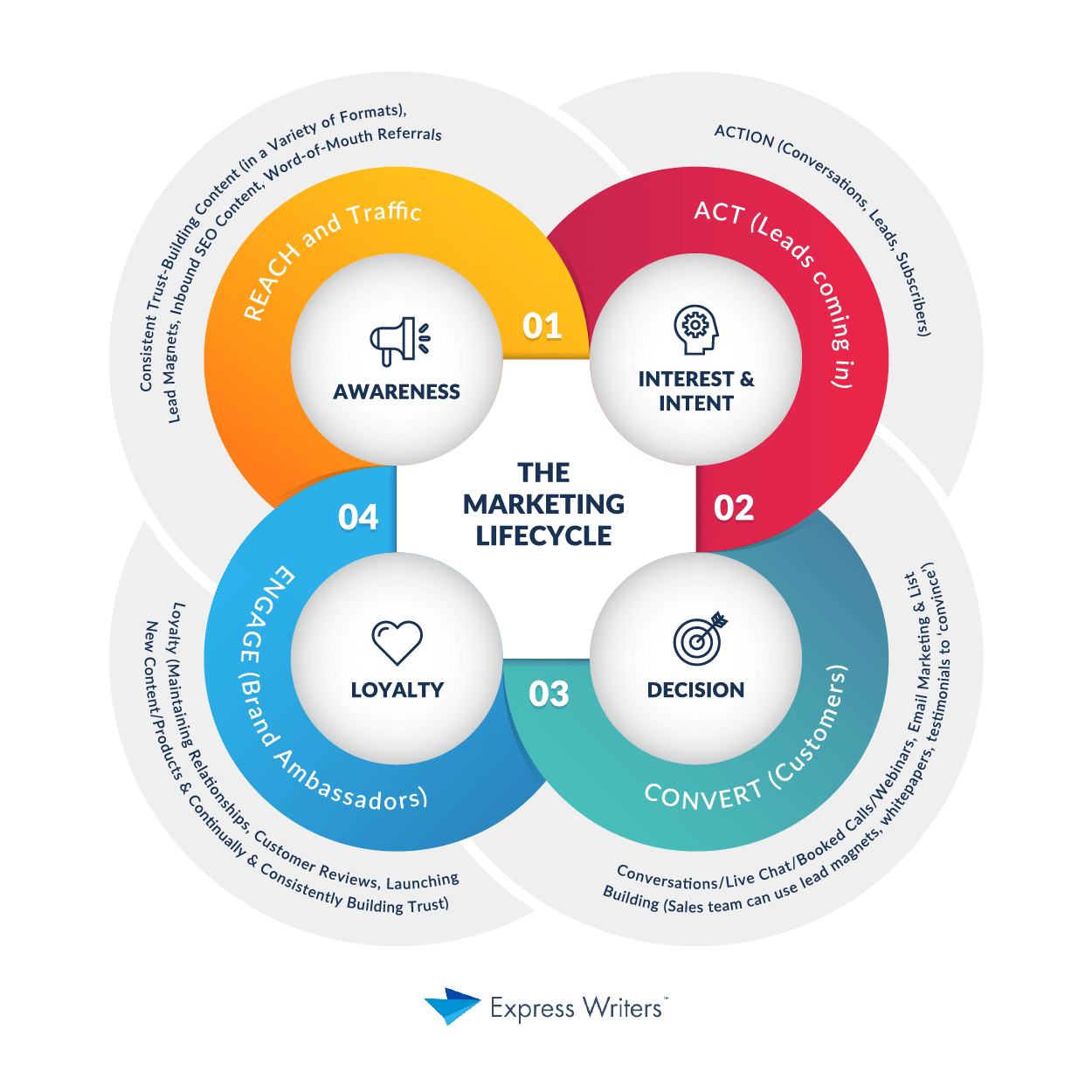
The content you create that’s targeted to specific buyer awareness stages will be far more useful and effective than random content. It will directly fulfill user search needs, speak to their problems and questions, and provide nurturing solutions right when they need it.
- Content to create when the buyer is in the Awareness stage (when they become aware of your brand and may need the solution you offer):
- Value-focused, comprehensive, high-quality SEO blogs
- Case studies or round-ups
- Original research
- Ebooks and lead magnets
- Creative blogs and stories that build brand awareness
- Informative guides and web pages
- Content that builds community
- Interest & Intent stage (the buyer is interested in your brand and could potentially buy):
- Whitepapers, case studies, and client testimonials
- Lead magnets that focus on your core brand message
- A website that’s easy to navigate with clear CTAs
- Conversational marketing, including live chat, phone calls, and messenger bots
- Webinars
- Decision stage (the buyer is ready to follow through and buy):
- More conversational marketing (live chats and follow-ups)
- A responsive sales team
- Work or product samples
- Client testimonials
- Loyalty stage (the buyer is delighted and ready to sing your praises):
- Brand updates (new services, new products, etc.) on your blog or social media
- Follow-up conversations
- Email marketing newsletters
- Authority content published consistently
You Need the Fundamentals of Online Writing to Engage, Inform, and Impact Your Readers
Online writing is unlike every other type of writing out there. If you attempt to approach writing for the web the same way you would write for a college class, a piece of fiction, a technical manual, etc., you’ll be in trouble.
Hone your writing skills and remember, to write successful online content, you need to know how to accommodate the average web user. To earn the online reader’s trust, to engage them and impact their lives, follow these 5 fundamentals of online writing and make it happen.

